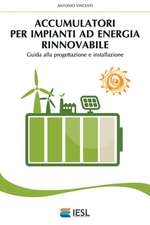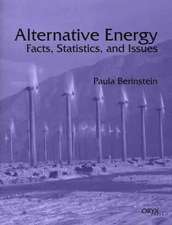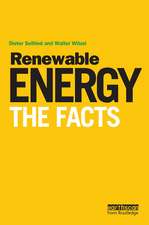Modeling and Analysis with Induction Generators: Power Electronics and Applications Series
Autor M. Godoy Simões, Felix A. Farreten Limba Engleză Paperback – 31 mar 2021
New to the Third Edition
- Revised equations and mathematical modeling
- Addition of solved problems as well as suggested problems at the end of each chapter
- New modeling and simulation cases
- Mathematical modeling of the Magnus turbine to be used with induction generators
- Detailed comparison between the induction generators and their competitors
Modeling and Analysis with Induction Generators, Third Edition aids in understanding the process of self-excitation, numerical analysis of stand-alone and multiple induction generators, requirements for optimized laboratory experimentation, application of modern vector control, optimization of power transference, use of doubly fed induction generators, computer-based simulations, and social and economic impacts.
Preț: 497.00 lei
Nou
Puncte Express: 746
Preț estimativ în valută:
95.11€ • 103.28$ • 79.89£
95.11€ • 103.28$ • 79.89£
Carte tipărită la comandă
Livrare economică 22 aprilie-06 mai
Preluare comenzi: 021 569.72.76
Specificații
ISBN-13: 9780367779160
ISBN-10: 0367779161
Pagini: 466
Dimensiuni: 152 x 229 x 24 mm
Greutate: 0.63 kg
Ediția:Nouă
Editura: CRC Press
Colecția CRC Press
Seria Power Electronics and Applications Series
ISBN-10: 0367779161
Pagini: 466
Dimensiuni: 152 x 229 x 24 mm
Greutate: 0.63 kg
Ediția:Nouă
Editura: CRC Press
Colecția CRC Press
Seria Power Electronics and Applications Series
Public țintă
UndergraduateCuprins
Principles of Alternative Sources of Energy and Electric Generation. Steady-State Model of Induction Generators. Transient Model of Induction Generators. Self-Excited Induction Generators. General Characteristics of Induction Generators. Construction Features of Induction Generators. Power Electronics for Interfacing Induction Generators. Scalar Control for Induction Generators. Vector Control for Induction Generators. Optimized Control for Induction Generators. Doubly Fed Induction Generators. Simulation Tools for Induction Generators. Applications of Induction Generators in Alternative Sources of Energy. Economics of Induction Generator–Based Renewable Systems.
Notă biografică
M. Godoy Simões holds a B.Sc, M.Sc, and D.Sc (Livre-Docência) from the University of São Paulo, Brazil, and a Ph.D from the University of Tennessee, Knoxville, USA. An IEEE senior member, Dr. Simões currently works at the Colorado School of Mines, Golden, USA, and is director of the Center for Advanced Control of Energy and Power Systems. Widely published and highly decorated, he was recently awarded a Fulbright Fellowship to conduct research and educational activities at the University of Aalborg, Denmark. Previously, Dr. Simões was a faculty member at the University of São Paulo.
Felix A. Farret received bachelor’s and master’s degrees in electrical engineering from the Federal University of Santa Maria (UFSM), Brazil. He specialized in electronic instrumentation at Osaka Prefectural Industrial Research Institute, Japan; earned an M.Sc from the University of Manchester, UK; received a Ph.D from the University of London, UK; and did a postdoctoral program at the Colorado School of Mines, Golden, USA. Widely published, he is currently a professor at UFSM. Previously, he worked as an engineer at the State Electric Power Company, Rio Grande do Sul, Brazil, and was visiting professor at the Colorado School of Mines.
Felix A. Farret received bachelor’s and master’s degrees in electrical engineering from the Federal University of Santa Maria (UFSM), Brazil. He specialized in electronic instrumentation at Osaka Prefectural Industrial Research Institute, Japan; earned an M.Sc from the University of Manchester, UK; received a Ph.D from the University of London, UK; and did a postdoctoral program at the Colorado School of Mines, Golden, USA. Widely published, he is currently a professor at UFSM. Previously, he worked as an engineer at the State Electric Power Company, Rio Grande do Sul, Brazil, and was visiting professor at the Colorado School of Mines.
Recenzii
"I have taught courses on renewable energy systems and induction machines, but I have never combined both of them together before. This book has shown me a new way of thinking. … The language and the examples are very accessible and intuitive. This book is ideal for a first read, an exam study, or a broad literature review."
—Luiz Fernando Lavado Villa, Laboratory for Analysis and Architecture of Systems, Toulouse, France
"To my knowledge, this is the only book devoted entirely to the induction generator, which would be sufficient reason to make it important for the international community of electrical and electronics engineers. ... The text is very didactic, being suitable to be used as a textbook in engineering schools, but also appropriate for consultation and self-education. There are a large number of solved problems, and also proposed problems, which serve as additional study tools for students. [The text] makes use of modern mathematical and computational tools used in the modeling, analysis, and simulation of power generation systems with induction generators. ... Following the examples of previous editions, the text is well planned, with sense of proportion between the various chapters. The main aspects of the induction generator [are covered], including constructive aspects, self-excitation, steady state analysis, transient analysis, scalar control, vector control, control-oriented modeling, simulation, and practical applications in renewable and alternative electric power generation. The text is clear and easy to follow and understand. The authors, both experienced instructors and researchers, have used all their didactic skills to approach the subjects, even those subjects usually considered complex, for the benefit of the readers, mainly graduate and undergraduate students of electrical engineering."
—Ivo Barbi, Federal University of Santa Catarina, Florianópolis, Brazil
"The text is easy to read and the figures are clear and comprehensive. The explanations are easy to follow and complete. The references to previous works are numerous and wide."
—Bertrand Raison, G2ELab, University of Grenoble, France
—Luiz Fernando Lavado Villa, Laboratory for Analysis and Architecture of Systems, Toulouse, France
"To my knowledge, this is the only book devoted entirely to the induction generator, which would be sufficient reason to make it important for the international community of electrical and electronics engineers. ... The text is very didactic, being suitable to be used as a textbook in engineering schools, but also appropriate for consultation and self-education. There are a large number of solved problems, and also proposed problems, which serve as additional study tools for students. [The text] makes use of modern mathematical and computational tools used in the modeling, analysis, and simulation of power generation systems with induction generators. ... Following the examples of previous editions, the text is well planned, with sense of proportion between the various chapters. The main aspects of the induction generator [are covered], including constructive aspects, self-excitation, steady state analysis, transient analysis, scalar control, vector control, control-oriented modeling, simulation, and practical applications in renewable and alternative electric power generation. The text is clear and easy to follow and understand. The authors, both experienced instructors and researchers, have used all their didactic skills to approach the subjects, even those subjects usually considered complex, for the benefit of the readers, mainly graduate and undergraduate students of electrical engineering."
—Ivo Barbi, Federal University of Santa Catarina, Florianópolis, Brazil
"The text is easy to read and the figures are clear and comprehensive. The explanations are easy to follow and complete. The references to previous works are numerous and wide."
—Bertrand Raison, G2ELab, University of Grenoble, France
Descriere
This Third Edition presents the fundamentals of and latest advances in the modeling and analysis of induction generators. It includes revised equations and mathematical modeling, the addition of solved problems as well as suggested problems at the end of each chapter, new modeling and simulation cases, mathematical modeling of the Magnus































